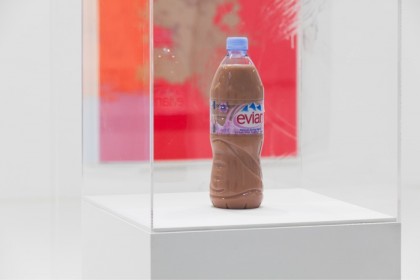 |
| Pamela Rosenkranz, Firm Being (Soft May), 2011, image: Swiss Institute |
Pamela Rosenkranz and Nikolas Gambaroff display works side by side in their respective shows, “This Is Not My Color” (Rosenkranz) and “The Seven Habits of Highly Effective People” (Gambaroff), for the Swiss Institute’s first exhibition in one of Jeffrey Deitch’s former gallery spaces. Twenty distinct pieces are strategically positioned in conversation with one another in Swiss Institute’s main space, and downstairs two projectors display Rosenkranz’s disturbing work Over My Brainbow, 2011, a haunting apparition of the Michael Jackson many will recognize from his later years. In one projection, Rosenkranz has superimposed a woman’s eyes over Jackson’s and they are taut, blinking, and hyperaware; his pale skin glows next to the other projection, which features a morphing rainbow’s ROYGBIV spectrum. The forced intimacy, between the two projections as well as between the viewer and the work itself, creates blatant discomfort and self-consciousness.
Both artists focus on the body as material and on the human figure as a reference point for closer philosophical inspection. Joining the ranks of people who have battled external forces set on pigeonholing or oversimplifying their existence, Rosenkranz and Gambaroff unveil the illusive notion of the human being as a prêt-à-porter item for consumption by reminding the viewer that though human qualities and traits are often compartmentalized or reduced in aesthetic objects, humanity remains irreplaceable. This is evident from the installation’s clean interior design aesthetic, which, in its evocation of showcase rooms promoting new apartments (and of modern-day domesticity in general), hints at the simultaneous appeal and danger of contrived plasticity. This point is further made by specific materials present, such as Evian water bottles filled with a flesh-toned substance, and tall lamp sculptures that stand alone, forcibly personified, on oversize rugs—placeholders for works previously sold. As such, these objects, especially the lamp, bring up comparisons between the individual, vapid household commodity, and artworks that are subject to liquidation. The exhibition suggests human beings are invaluable, as their wide array of traits, ambitions, and foibles are not, despite attempts, easily mimicked or represented, and thus cannot be sold. What it means to be human—that invitation to overused parody and abused metaphor—surfaces in these works, as we perceive the coincidence of vacancy intermingling with the substantive, inciting an urge to both preserve authenticity and to come to terms with the forged. Straightforward object or sly feint, organism or machine, original or reproduction—the line between such spheres is inspected, along with the ways science and technology simulate the real while expanding the unreal.
To see the review in context, click here.








